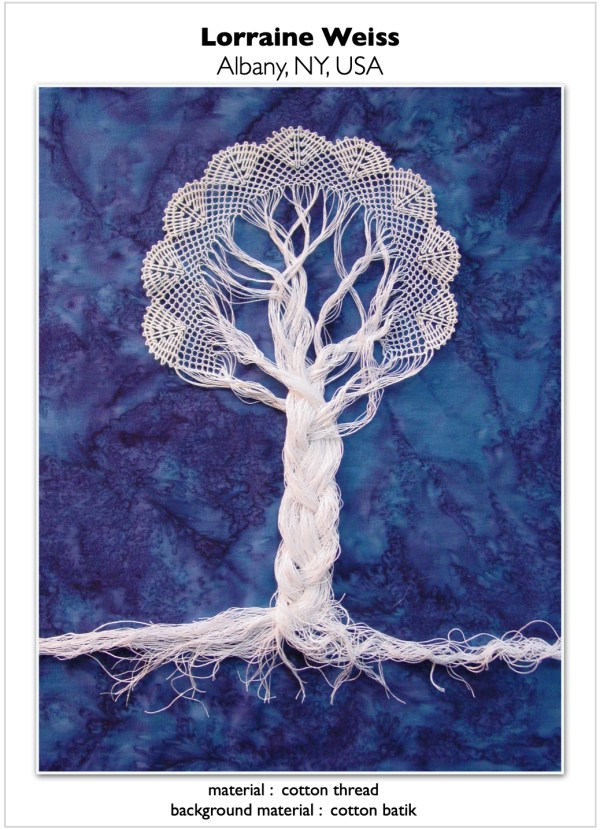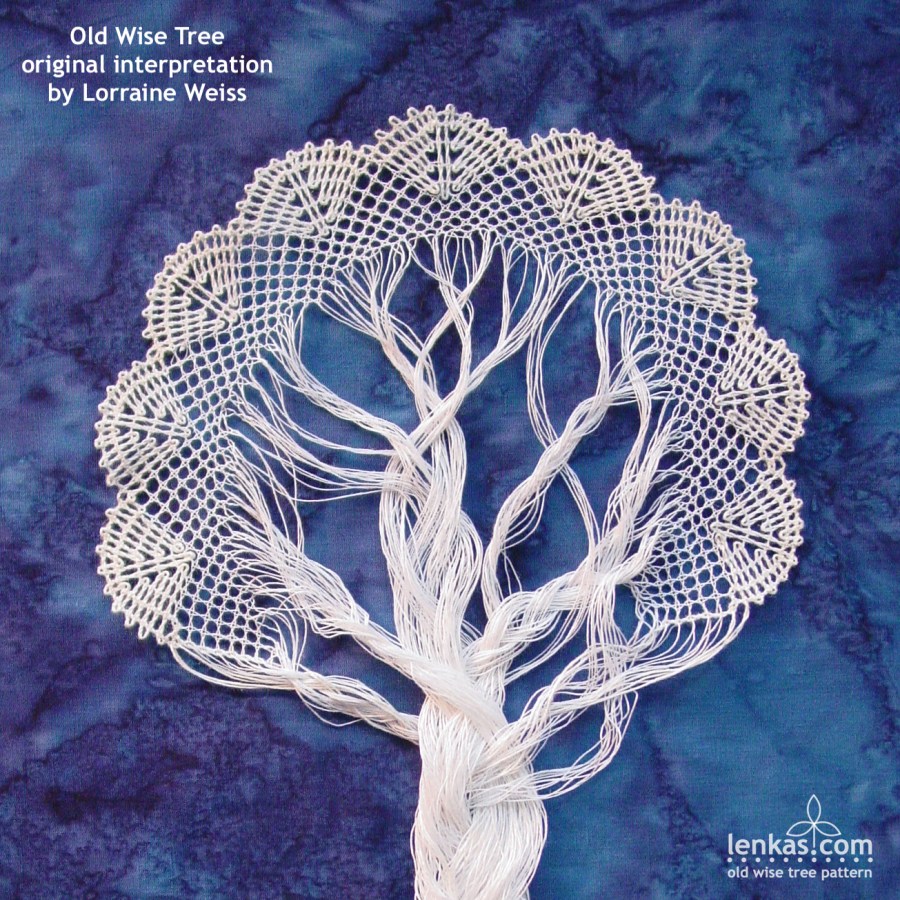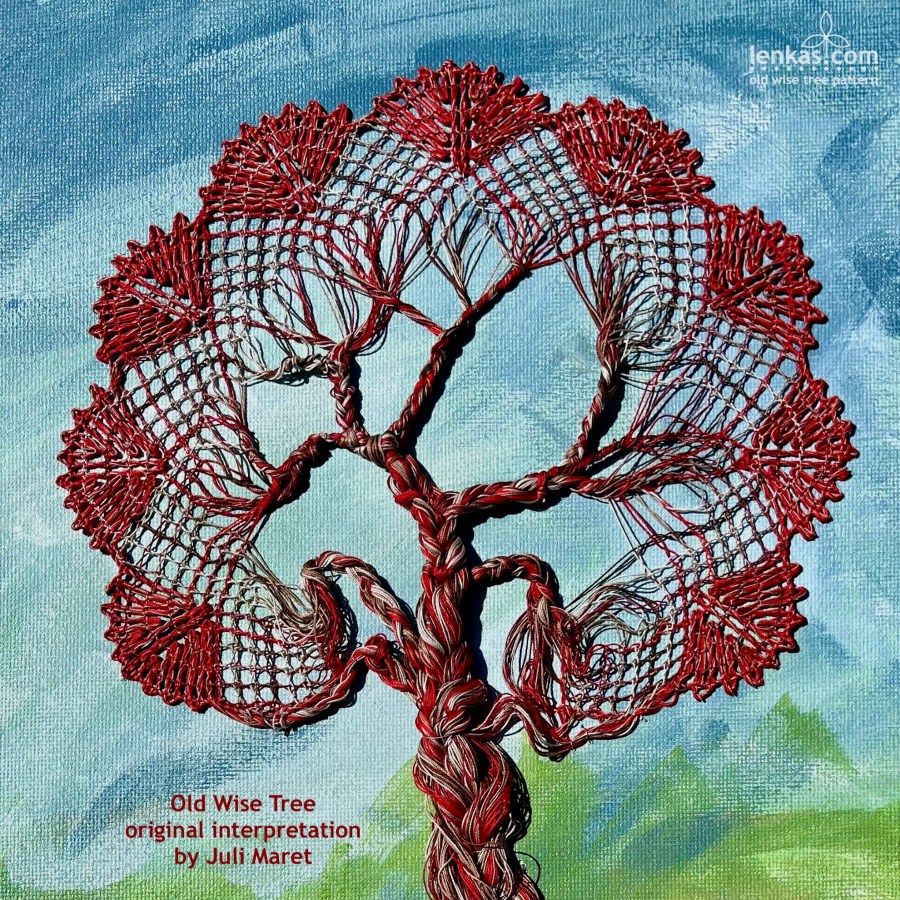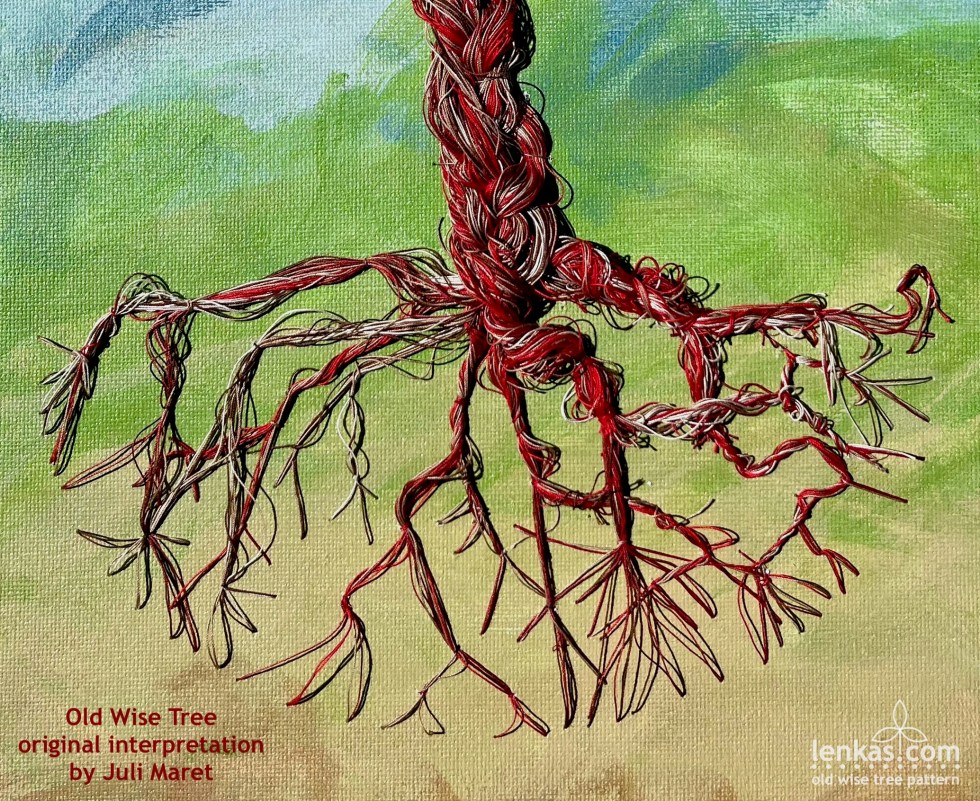Time to Grow
Posted on April 22, 2024
April 22, 2024
Spring is a wonderful season. Watching the nature waking up and making the most amazing shapes and colours seemingly out of nothing is the best inspiration for creative souls.
It never fails to fill me with awe and and urge to participate.

For many years now, my first spring project is the seedling, the simplest pattern that I ever designed. And I just can’t seem to grow out of it 🙂
I love leaf tallies in bobbin lace, and I love to make them in wire. The seedling is therefore an ideal pattern because it has nothing else than two leaves. The cotyledons are completed with the seed they originate from, and together they symbolize the new beginning, new life, new energy.
The seeds I like to use for the seedling are rudraksha seeds from India. Their name means “Tears of Shiva” and are considered to be auspicious and valuable as an instrument for inner transformation. The rudraksha seeds have been used for millennia as prayer beads. I found them in the Little India district in Vancouver where I used to browse and admire the traditional Indian arts and crafts. I always liked the shape and feel of the rudraksha seeds, even before I learned about their ancient history. They just looked like true seeds, and being round and wearable made them the best choice for the seedling pendant.
As I keep learning a little bit more about Indian spiritual traditions, I find it very interesting that in continuity of the ancient wisdom, a movement to Save Soil originated in India and is spreading around the world. It connects all aspects of environmental stewardship back to the health of the soil, and therefore has a potential to spearhead a real change. Because seedlings of any kind can germinate only in good soil.
Every year when the spring comes I make the seedling pendants. I like to wear them, too. More like a lucky charm than jewellery, especially when working in the garden, because in that field I am a complete amateur and need a lot of help from Mother Nature (the pendants are pretty hardy and can withstand a lot of wear and tear). Other seedlings get dispersed to family and friends with green thumbs, and sometimes strangers too, with an occasional overstock being donated to a local garden club’s annual plant sale/fundraiser.

To spread the seeds even further, the Seedling Pattern and Tutorial became available as part of Basic Series of my patterns for wire lace. Not that I expect there are many more lacemakers crazy about seedlings, but this simple design is truly good for practicing those leaf tallies!
Spring is in full swing, and if you feel like growing some plants, or lacemaking skills, give the Seedling a try!

Happy lacemaking to you all 🙂
Old Wise Trees in the United States of America
Posted on April 18, 2024
April 18, 2024
Yes, the Old Wise Trees grow in the United States of America as well!
I always thought so, even heard about them occasionally, and wondered whether they will ever allow to be seen. Finally it happened. Two trees arrived within the same week as a delightful proof. They are beautiful, each in its own distinctive way, and they aptly represent the eclectic nature of lacemaking craft in America.
One of the trees is not just old, it is ancient. It was made it in 2008, which means that the pattern must have come from my old Silver Pin Studio website. I remember offering a free pattern there with very basic instructions, leaving it up to lacemakers to figure out a lot of steps on their own. It was quite common in those times. Lacemaking was young and rather rare craft in North America. Lacemakers who were few and spread all over the vast continent had to be resourceful and self-sufficient. When I eventually met some of them I found them to be keen, dedicated and fun to work with. They were open to learning any technique, from traditional to modern, in any material, from fine threads to wire. Without ingrained traditional styles, it was possible to explore and expand handmade lace together toward new horizons.
With the same enthusiasm, the American lacemakers embraced internet and started to share resources online. Interestingly, some lacemakers, especially in California, were employed in computer industry and were quite proud about the connection between binary code in software and bobbin lace. Looking back, I don’t think any of us imagined how much and how fast will internet help with preserving the fine craft of lace by making the sources readily accessible for many lacemakers around the world.
And I did not know then that Old Wise Tree project will one day have its own online gallery!
That ancient wise tree I am talking about was made by Lorraine Weiss of Albany, New York. And it is very well done.

In pristine white thread standing out against deep blue background, the tree looks immaculate. White was the colour of choice for most handmade laces throughout the history. As the colour symbolizes innocence and purity, it was considered auspicious for celebrating special occasions in women’s life. The delicate white lace was cherished and treasured as part of cultural and familial heritage.
Lorraine made the Old Wise Tree for her niece, whose Bat Mitzvah torah portion was on the Tree of Life. And it fulfilled the purpose beautifully – the tree stands tall and strong, its widely spread roots foretelling long, fruitful life. With precise torchon ground of the crown and neatness of braided branches and trunk the tree looks composed and serene. Blues in the background add not only visual, but also spiritual depth to the whole picture, elevating this Old Wise Tree to a very special family heirloom. Wonderful work, Lorraine!



The Old Wise Tree from Juli Maret of St. Louis, Missouri, is equally beautiful yet totally different.

Juli’s choice of cotton thread in six contrasting colours works really well. Unexpected vivid reds give the tree intensity, character and unapologetic originality. They infuse the crown with joie de vivre, and continue to flow through the branches, trunk and roots like blood running in the veins of this flourishing tree. The tightly braided branches and trunk look so realistic, one almost forgets that they are made from soft fibres. Only the gnarly trunk and roots communicate the wisdom collected through many seasons, and readiness to face more with strength and passion.
Expressive background hand painted in acrylics on canvas greatly contributes to the picture’s originality. While it suggests all earthly elements needed for the physical growth, it allows the tree to live in its own space, exalted and jubilant.
Great interpretation of the Old Wise Tree theme. Congratulation, Juli!




Looking at these trees, and all other in the Old Wise Tree Gallery, I am overwhelmed by a humble joy from realization that a very simple pattern from my lace workshop has inspired so much creativity and beauty. I feel like being in nature and observing living trees where I often wonder if trees know how magnificent they are. They never respond, they just are. And I always tell them: “Yes, you are very beautiful and I am happy to share the life on Earth with you!”
Old Wise Tree Gallery is always open and welcomes all visitors!
The Free Old Wise Tree Pattern and Tutorial was published on this website on January 16th, 2021.
With thirty two trees from eight countries submitted to the online exhibition, together we are slowly growing an Old Wise Grove. Big thanks and a round of applause to all participating lacemakers!
Are there more lace trees growing in the world?
Please consider reaching out by sending a photo of your tree with following information to this email address:
Your Name + City / Country + Materials used + Pricking size (if different than the original 100%)
+ Optional: Notes (any specific information you would like to add)
**************************************************************************
Disclaimer: By submitting the photo/s and requested information you agree that your work will be displayed in the Old Wise Tree Gallery hosted on this website.
**************************************************************************
Happy lacemaking,
Lenka
Category: Blog Tagged: handmade bobbin lace, exhibition, free pattern, old wise tree, bobbin lace art, USA
Remembering Barbara Jean Jones and the lace|heart|art challenges
Posted on April 8, 2024
April 8th was a special date in the New School of Lace. On this day, for three consecutive years of 2018, 2019 and 2020, we celebrated an opening of the lace|heart|art, International Online Exhibition of Handmade Bobbin Lace in Colour . We took delight in sharing beautiful lace creations from all around the world with online audience. Each heart reminded us of our dear friend, Barbara Jean Jones, whose memory the lace|heart|art challenge was dedicated to.


The following years brought another kind of challenge, rather devastating to small artisanal workshops. While the New School of Lace was closed, the lace|heart|art competition was put on hold. Unfortunatelly, it was not possible to reopen the school and resume all related projects.
Yet the lace|heart|art challenge still lives on this website. The free patterns and working instructions are still available and are frequently downloaded by many visitors. That makes us think that the heart patterns are still doing their magic, inspiring lacemakers to explore colours in handmade bobbin lace. With instructions offered in fibre as well as wire medium, lacemakers are encouraged to explore both materials. Making the heart in traditional threads and then in wire provides a wonderful comparison between the two mediums. I often recommend it as a self-study project to lacemakers who are asking questions about wire lacework.
Barbara first learned lacemaking with fibre, like most of my students, and she enjoyed working on patterns of torchon, bucks point and tape lace. And then she really wanted to learn how to work with wire. Because she loved colours, she was attracted by brilliant hues of coloured copper and also by potential of embellishing wire lace with crystal beads.
Barb’s slender hands had a delicate lacemaker’s touch, and she found working with wire difficult at the beginning. With her characteristic enthusiasm and perseverance, she practiced new tensioning techniques on a simple heart pattern until she succeeded. Handmade bobbin lace in wire proved to be a perfect match for young lacemaker’s imagination and creativity, and she enjoyed the fine craft as long as she could.


Today would be Barb’s thirty seventh birthday. She remains in our hearts, and her positive attitude lives on as an inspiration for us to face life challenges with acceptance, equanimity and love.
Let’s keep the lace|heart|art alive for present and future!
Free Patterns :
1st lace|heart|art challenge 2018 – free pattern and working instructions
2nd lace|heart|art challenge 2019 – free pattern and working instructions
3rd lace|heart|art challenge 2020 – free pattern and working instructions
Online Exhibitions :
1st lace|heart|art online exhibition
2nd lace|heart|art online exhibition
3rd lace|heart|art online exhibition
Category: Blog Tagged: bobbin lace in wire, exhibition, free pattern, handmade bobbin lace, lace heart art
 Lenka's Way of Lace
Lenka's Way of Lace